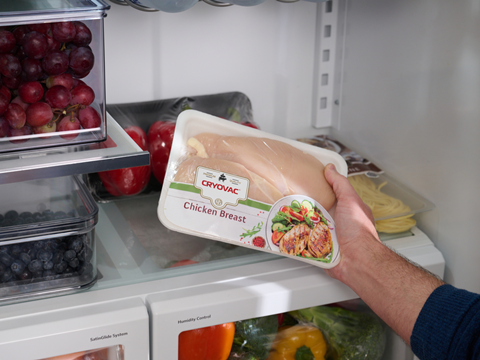
Eastman and SEE (formerly Sealed Air) have launched a lightweight, certified compostable tray, designed to replace traditional polystyrene foam alternatives in protein packaging applications.
The new tray is made using Eastman’s Aventa Renew material; these are made from wood pulp and acetyl from a portfolio of recycled material. Regarding the latter, Eastman elaborates that it contains up to 43% recycled content certified by ISCC PLUS via a mass balance allocation process.
The company also underlines its own FSC Chain of Custody certification and claims that all its suppliers are certified under FSC or PEFC Chain of Custody.
Meanwhile, SEE’s CRYOVAC compostable overwrap tray is certified as industrially compostable and free of PFAS. Said to be around 50% lighter than PET trays, it is designed to package protein products in a range of sizes, portions, and quantities, as well as offer leak resistance.
As a result, the jointly-developed tray is certified as home compostable by TÜV Austria, and as industrially compostable by the Biodegradable Products Institute (BPI). As it primarily contains cellulose acetate derived from wood pulp, it can apparently decompose under naturally occurring microbes without leaving microplastics behind.
Eastman and SEE add that the tray is compatible with existing industrial food packaging equipment and is already in use for several market applications.
“One of the most exciting features of these trays is that they perform like traditional plastic in a challenging atmosphere and yet provide an end-of-life solution through composting — a “win-win” for the environment,” said Jeff Carbeck, Ph.D., Eastman vice president of corporate innovation.
“The work we’ve done with Sealed Air demonstrates the commitment of both companies to fulfill circular economy commitments. Aventa Renew and the CRYOVAC brand combine uncompromising performance with environmental responsibility.
“We congratulate Sealed Air on this product launch, and we know it will help demonstrate Aventa Renew’s status as a game changer for the food industry.”
“Encouraging development of a circular plastics economy takes dedication and collaboration from all aspects of the value chain, including where we source our materials,” added Tiffani Burt, Ph.D., executive director of Strategic Marketing and Sustainability for the Americas at SEE. “Our CRYOVAC brand compostable overwrap tray would not be possible without the ingenuity of the product we use from Eastman, and we are excited to partner with them to bring this innovative tray to the market.”
In response to increasing legislative restrictions on takeaway containers, TIPA has developed its own biobased, recyclable, home compostable tray – this one derived from rice waste. It is set to replace both plastic and paper food packaging.
Meanwhile, Klöckner Pentaplast claims to have developed the first food packaging tray composed entirely of recycled tray material with its Tray2Tray closed-loop initiative. This system recovers used food trays and recycles them back into more food trays in an effort to establish a closed loop of ‘safe, protective, fully recyclable’ food packaging.
If you liked this story, you might also enjoy:
The Brief: How viable is biorecycling for plastics?
Report: How the top brands are progressing on packaging sustainability
The Brief: Using ocean-bound plastic in packaging – how, why and should we?












No comments yet